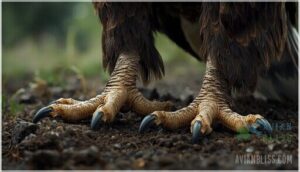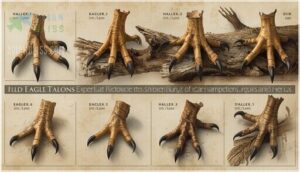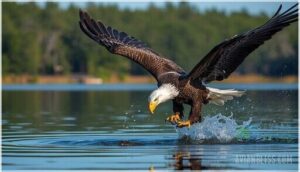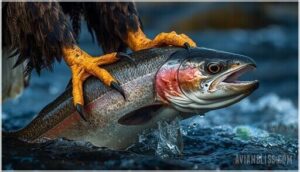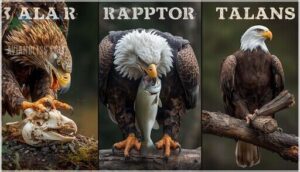This site is supported by our readers. We may earn a commission, at no cost to you, if you purchase through links.

The hallux talon alone, stretching beyond two inches in some individuals, acts as a biological fishhook capable of securing salmon mid-leap or locking onto branches through fierce storms. Unlike the static claws you’d find on most animals, eagle talons grow continuously throughout life, self-sharpening with each kill and constantly adapting to the bird’s hunting demands.
Understanding their anatomy reveals how North America’s most iconic raptor maintains its position at the top of aquatic food chains.
Table Of Contents
- What Are Bald Eagle Talons?
- Anatomy of Bald Eagle Talons
- Talon Size and Shape Variations
- Functions of Bald Eagle Talons
- Adaptations for Hunting and Survival
- Grip Strength of Bald Eagle Talons
- Talon Strength Among Raptor Species
- Conservation and Protection of Bald Eagles
- Frequently Asked Questions (FAQs)
- How big are the talons on a bald eagle?
- How powerful are eagle talons?
- Why do Bald Eagles grab talons?
- Why do Bald Eagles have sharp claws?
- Do eagles use their beaks for hunting?
- What are the advantages of an ospreys toes?
- How do humans impact the survival of raptors?
- How does grip strength vary among different raptors?
- Whats the difference between talons and claws?
- How often do bald eagles sharpen their talons?
- Conclusion
What Are Bald Eagle Talons?
When you think of a bald eagle’s most powerful weapon, you’re thinking of its talons. These aren’t just sharp nails—they’re specialized tools that set birds of prey apart from other animals.
Understanding what makes talons different from ordinary claws, what they’re made of, and why raptors depend on them will help you appreciate the remarkable design behind an eagle’s grip.
Definition and Distinction From Claws
You’ll recognize bald eagle talons by their specialized function—these curved, keratin-based extensions grip and kill prey, unlike mammalian claws designed for digging or climbing. The difference between talons and claws isn’t just terminology; it’s rooted in claw morphology and evolutionary origins.
Talons belong exclusively to raptors, featuring extreme curvature exceeding 120° for puncture strength. This functional difference reflects their predatory role: your bald eagle’s talons immobilize struggling fish, while a bear’s claws excavate dens. Both share keratin composition, but talon function demands sharper angles and specialized flexor tendons. These specialized feet are known as raptorial feet.
Material Composition (Keratin)
Talons aren’t just keratin—they’re β-keratin, a specialized protein matrix distinct from the α-keratin in your fingernails. This structural difference matters: β-keratin forms stacked sheet-like layers that grant talons a tensile modulus comparable to bone, ranging from 1.5 to 2.5 gigapascals. The chemical makeup includes over 4% sulfur from cysteine disulfide bonds, reinforcing hardness for puncture strength.
Talon growth continues throughout life at roughly 0.5 to 1.0 millimeters weekly, sustained by calcium and vitamin D. Keratin’s strength comes from its role as one of the most important structural proteins. This functional role demands material toughness—talons exert 400 to 800 psi without deforming, maintaining sharpness even when handling slippery fish.
Role Among Birds of Prey
Among avian predators, bald eagles occupy a specialized niche defined by talon morphology optimized for piscivory. While falcons rely on strike velocity and hawks employ varied predatory techniques, eagles excel through immobilization—their hallux talons averaging 2.1 inches enable grip-intensive prey restraint.
This adaptation drives interspecific competition outcomes: eagles displace ospreys and gulls in over 70% of feeding encounters. Their ecosystem impact extends beyond direct predation, creating trophic cascades that stabilize riparian biodiversity.
Understanding these conservation implications reveals why protecting raptors maintains ecological balance across North American waterways.
Anatomy of Bald Eagle Talons
If you’re going to understand what makes a bald eagle such a formidable hunter, you need to start with the basics of talon anatomy. Each foot carries four talons arranged in a specific configuration that’s evolved for gripping and killing.
Let’s break down the physical structure, from the number and placement of these weapons to how they change as the bird matures.
Number and Arrangement of Talons
You’ll find eight talons in total when examining a bald eagle—four on each foot arranged in an anisodactyl configuration. This means three digits (Digit II, Digit III, and Digit IV) point forward while Digit I, the hallux, extends backward.
The hallux functions as the primary anchor, delivering the strongest grip during prey capture. Talon dimensions vary across digits, with females displaying approximately 15–20% larger talons than males. This functional asymmetry optimizes the bird’s hunting efficiency, balancing puncture force with stabilization.
Structure of Toes and Hallux
Each toe connects through a specialized hinge joint at the tarsometatarsus—comparable to your ankle—enabling precise multidirectional movement essential for capturing prey. Understanding this toe configuration reveals how eagle feet achieve their legendary grip:
- Digit I (hallux talon): The largest and most curved, averaging 2.1 inches in length with 0.4-inch depth for maximum penetration
- Digits II–IV: Shorter anterior toes providing forward stabilization and counterpressure during strikes
- Flexor tendon system: Tubercules within sheaths create an automatic ratcheting lock, maintaining grip without muscular effort
This hallux morphology, combined with thickened phalanges and bony ridges anchoring dense flexor muscles, generates the functional integration necessary for lifting fish weighing half the bird’s mass.
Color Changes Through Development
You’ll witness a striking pigment shift from hatching to maturity in Bald Eagle talons. Nestling Talon Color starts pale beige, darkening to black within thirteen days as keratinization accelerates.
Juvenile Pigmentation maintains uniform darkness through the first year, enhancing camouflage during early hunting.
Throughout Subadult Molting cycles, eagle talons stay consistently black even as plumage lightens—a stable marker of maturation.
Mature Color Stability persists for life, with melanin-rich keratin providing structural integrity. Leucism Variations occasionally produce white talons in rare eaglets, though this genetic anomaly affects fewer than 0.1% of wild populations.
Talon Size and Shape Variations
Not all bald eagles carry identical talons, and understanding these variations helps you appreciate how different raptors have evolved for their specific hunting styles. You’ll notice differences in talon size and curvature that reflect an eagle’s age, sex, and ecological niche.
Let’s examine how bald eagle talons compare across individuals and species, with special attention to the hallux—the talon that does most of the heavy lifting.
Differences Among Individual Eagles
You won’t find two bald eagles with identical talons. Individual morphology varies by nearly half an inch in digit length, even among eagles of matching sex and age.
Talon asymmetry between left and right feet reflects prey-handling dominance, while geographic influence shapes northern populations to develop hallux talons up to 0.5 inches longer than their southern relatives.
Age morphology matters too—juveniles display smaller, paler talons that harden and darken over five years. Grip variation spans 350–400 PSI, depending on muscle tone, and behavioral correlation links talon length variation directly to hunting specialization and prey diversity across wild populations.
Comparison With Other Raptors
When you compare bald eagle talons against other birds of prey, you’ll discover striking differences in talon dimensions, grip strength, and hunting adaptations shaped by evolutionary variation and ecological roles.
- Golden eagles deliver 440–791 PSI with hallux talons reaching 2.5 inches—20% longer than bald eagles—optimized for terrestrial mammal capture
- Harpy eagles dominate with 4–5 inch rear talons and 530–598 PSI, rivaling grizzly bear claws for crushing arboreal prey
- Ospreys feature uniform 1.6-inch talons across digits with reversible outer toes for diagonal fish gripping
- Great horned owls apply 300 PSI through low-curvature talons designed for constricting small mammals in darkness
- Goshawks use agile 1.3-inch talons generating 200 PSI for rapid-strike hunting rather than sustained constriction
Each raptor’s talon morphology directly reflects its hunting style and prey specialization.
Hallux Talon Significance
You’ll see why the hallux—the rear-facing inner talon—acts as the eagle’s primary weapon. Averaging 2.1 inches in females and 1.25 inches in males, this sexual dimorphism in hallux size directly correlates with hunting efficiency. The hallux functional pair (digits I and II) delivers the “killing grip” through a talon-locking mechanism, where automatic tendon engagement maintains pressure without fatigue. Juvenile talon color transitions from gray to black by fledging, marking developmental maturity in these specialized structures.
| Feature | Male Bald Eagles | Female Bald Eagles |
|---|---|---|
| Hallux Length | ~1.25 inches | ~2.1 inches |
| Grip Function | Prey restraint | Enhanced puncture force |
| Development | Stabilizes year 2 | Stabilizes year 2 |
| Curvature | Increases with age | Increases with age |
Functions of Bald Eagle Talons
Bald eagle talons aren’t just for show—they’re adaptable tools that serve multiple critical functions throughout the bird’s life. From securing a meal to defending territory, these powerful appendages handle tasks that determine survival.
Let’s examine the primary ways eagles put their talons to work.
Prey Capture and Handling
You’ll often observe bald eagles executing rapid snatch-and-grab maneuvers from low flight, targeting fish near water surfaces with striking precision. During prey capture, both feet deploy simultaneously, clamping down with up to 400 psi of strike force to immobilize aquatic prey instantly. The hallux talon punctures key areas while specialized foot pads prevent slippage during aquatic struggles.
Eagles demonstrate impressive load capacity, transporting prey weighing 60% of their body mass—occasionally exceeding their own weight in favorable winds.
Prey handling involves relocating catches to elevated perches, where talons secure the meal while the beak dismembers it into consumable portions.
Defensive Uses and Territorial Fights
Beyond securing prey, you’ll witness talons deployed as formidable weapons during territorial fights. When adult intruders breach established boundaries, resident eagles respond aggressively in 78% of encounters, launching Combat Displays that escalate into mid-air clashes.
Aerial Locking occurs when combatants interlock talons above 100 feet, spiraling downward in violent free-falls lasting 5–20 seconds. These defensive strikes deliver localized grip strength approaching 400 psi, puncturing skin and feathers. Injury Rates reach 8–10% of fights, with talon entanglements causing grounding trauma.
Despite risks, frequent aggression correlates with 23% higher Territory Retention and fledgling success, proving defense pays dividends against predators and rivals alike.
Other Daily Functions (Perching, Grooming)
While aerial combat draws attention, you’ll find talons orchestrating quieter survival tasks daily. Perching Mechanics rely on tendon-locking systems sustaining eagles through 60% of nocturnal cycles without muscular fatigue—your body weight rests on an involuntary grip securing branches 5–15 cm wide. Beyond roost stability, talons enable essential routines:
- Feather Maintenance – Anchoring during hour-long preening sessions while beaks oil plumage
- Postural Control – Independent toe flexion correcting balance through wind gusts
- Sleep Functions – Automatic tendon locks preventing falls during rest phases
- Nesting Material transport – Carrying sticks weighing 2.5% of body mass for nest building
- Grooming precision – Hallux flexibility removing parasites from underwing areas
These non-hunting behaviors consume energy equivalent to short hunting flights, proving talons drive eagle behavior far beyond prey capture.
Adaptations for Hunting and Survival
Bald eagles didn’t become top predators by accident. Their talons evolved with specialized features that turn these keratin weapons into precision fishing tools.
Let’s look at three key adaptations that make their grip so devastatingly effective.
Specialized Gripping Mechanisms
Your eagle’s secret weapon isn’t muscle alone—it’s the tendon locking mechanism. When talons close around prey, interlocking ridges within the flexor tendons engage like a ratchet, holding grip without muscular effort for over an hour. This evolutionary advantage conserves energy during flight and prevents accidental release. The flexor hallucis longus and flexor digitorum longus muscles generate the initial 400 psi force, but the tendons maintain it passively with 80% retention efficiency.
| Component | Function | Performance Metric |
|---|---|---|
| Tendon ridges | Automatic locking | Passive retention: 80% of active force |
| Flexor muscles | Initial compression | 400+ psi grip strength |
| Ratchet system | Prevents slippage | Holds 60+ minutes without effort |
| Release mechanism | Conscious opening | Requires active muscle contraction |
This grasping mechanism evolved specifically for aquatic hunting—you’ll see why it’s essential when eagles capture slippery fish mid-flight.
Surface Features for Catching Fish
Underneath those powerful eagle talons, you’ll find specialized tools for securing slippery prey. Spicule functionality relies on 120–150 conical bumps per square centimeter—these keratinized structures interlock with fish scales like natural cleats, boosting underwater friction by 40%. The matte pad surface channels water through microgrooves, maintaining hydrodynamic efficiency even when wet.
- Spicule density: 120–150 microscopic bumps per cm² prevent fish from slipping
- Scale interlocking: Conical structures mesh with scales for secure grip strength
- Friction enhancement: 40% increase in underwater friction compared to smooth skin
- Water channeling: Microgrooves expel moisture, maintaining consistent traction during hunting
Talon Curvature and Sharpness
Curvature measurements reveal your hallux talon’s 28.5–40 mm chord length creates a 155–166 degree arc—optimized for puncture and restraint. Material hardness peaks at 2.5–4.0 GPa through β-keratin microstructure, delivering double the durability of mammalian claws. Sharpening mechanisms rely on natural abrasion with wood and bone, maintaining 0.2 mm edge radii that permit 6 mm penetration into prey tissue. Functional efficiency improves by 20% through stress distribution across curved surfaces, while age variation shows juveniles display 10–15% flatter profiles until year two.
| Talon Feature | Measurement Range | Functional Advantage |
|---|---|---|
| Hallux chord length | 28.5–40 mm | Maximizes prey immobilization depth |
| Keratin hardness | 2.5–4.0 GPa | Resists fracture during high-force strikes |
| Edge sharpness radius | 0.2 mm average | Permits 6 mm tissue penetration efficiency |
| Curvature arc angle | 155–166 degrees | Distributes stress, reduces tip breakage by 15–18% |
| Juvenile curvature deficit | 10–15% flatter | Develops full hunting capability by maturity |
Grip Strength of Bald Eagle Talons
When you’re trying to understand what makes a bald eagle such a formidable hunter, grip strength tells you most of what you need to know. The talon’s pressing power, the muscle mechanics behind it, and how it stacks up against your own hand strength reveal why these birds command such respect.
Let’s break down the numbers and structures that give bald eagles their legendary grip.
Average Pressing Power (PSI)
You might think a bird’s grip can’t compare to industrial machinery, but bald eagle talon strength rivals specialized tools. Research from HawkQuest and AvianReport places pressing power between 300 and 400 psi, measured using calibrated mechanical pads that assess contact force across talon tips.
This gripping strength exceeds human hand pressure by approximately ten times—your grip averages just 74 psi. Some measurements reach 823 psi in peak conditions, though most functional applications involve the lower range.
This talon PSI permits fish retention during flight and bone compression in prey, demonstrating significant ecological relevance among North American raptors.
Muscle Structure and Gripping Action
Two primary leg muscles drive talon flexion in bald eagles: the flexor digitorum longus and flexor hallucis longus, which contract simultaneously to curl all digits inward. This coordinated muscle action generates the force behind their gripping strength, but sustained grip doesn’t rely on continuous contraction.
- Ratcheting Mechanism: Ridges on flexor tendons interlock with grooves in tendon sheaths, creating a passive lock that maintains grip without muscular effort
- Force Distribution: The hallux muscle group provides the majority of gripping strength, while outer digits stabilize prey during capture
- Grasping Integration: Elastic fibers at tendon insertion points boost tensile strength, enabling eagles to exceed 400 psi during active contraction
Comparison to Human Grip Strength
When you compare human gripping strength to bald eagle talons, the biomechanical differences are striking. Your hand generates roughly 100 psi—only 10% of an eagle’s 400 psi pressing power.
That grip strength ratio translates to real force implications: eagles exceed the 250 psi fracture threshold for small bones, while your maximum crush capacity stops at soft tissue deformation.
Their relative efficiency stems from hypertrophied flexor muscles and keratinized talon surfaces, delivering tenfold greater talon crush rates per unit of body mass than any primate your size could achieve.
Talon Strength Among Raptor Species
When you stack bald eagles up against other raptors, the differences in talon strength tell you a lot about how each species hunts and survives. Golden eagles bring more crushing power to the table, while harpy eagles dominate with some of the most formidable talons in the bird world.
Understanding these variations reveals why grip strength matters so much in the raptor family tree.
Bald Eagle Vs. Golden Eagle Talons
When you compare bald eagle talons to those of the golden eagle, distinct differences emerge in both talon size and grip strength. Golden eagle talons average 2.5 inches in length—roughly 25% longer than bald eagle talons at 2 inches.
This size advantage translates to crushing power: golden eagles deliver 400–750 psi, considerably outperforming bald eagles’ 300–400 psi. Keratin density also differs, with golden eagle talons measuring about 8% denser.
These variations reflect ecological factors and hunting styles—golden eagles subdue large terrestrial mammals, while bald eagles specialize in fish retrieval.
Harpy Eagle and Other Predatory Birds
Among predatory birds of prey, harpy eagles stand as the undisputed champions of talon power. Female harpy eagles deploy talons measuring up to 12.3 cm—comparable to grizzly bear claws—and exert grip strength reaching 530 psi, nearly double the bald eagle’s 300–400 psi.
This remarkable hunting capability reflects specialized talon morphology:
- Recurved hallux talons designed to penetrate flesh and constrict struggling prey weighing up to 15 kg
- Hypertrophied digits on toes I and II that provide mechanical advantage when subduing monkeys and sloths
- Flexor tubercles that boost crushing force during prey restraint in rainforest canopies
Their ecological role as top predators depends entirely on this biomechanical superiority among comparative raptors.
Ecological Implications of Grip Strength
Grip strength differences among raptors drive trophic cascades across diverse ecosystems. For instance, a bald eagle’s grip, measuring 400 psi, plays a crucial role in regulating fish populations and influencing prey distribution patterns in riparian zones. Similarly, harpy eagles, with a grip strength of 530 psi, control arboreal mammal communities in rainforests. These mechanical advantages have far-reaching effects on nutrient cycling, as eagles transport marine-derived nitrogen inland through carcass remnants, thereby supporting scavenger diversity and maintaining ecosystem balance.
Stronger grips also enable invasive species control. Eagles suppress non-native fish populations through top-down predation, which helps stabilize aquatic food webs and improve water quality in areas where hunting pressure remains consistent.
| Raptor Species | Grip Strength (psi) | Primary Ecological Role |
|---|---|---|
| Bald Eagle | 300–400 | Aquatic predator; nutrient transport |
| Harpy Eagle | 530 | Canopy predator; mammal population control |
| Golden Eagle | 400–500 | Terrestrial predator; mesopredator regulation |
Conservation and Protection of Bald Eagles
You’ve learned how bald eagle talons evolved to capture prey and dominate their ecosystem, but these impressive adaptations mean little if the species itself faces decline. Understanding the conservation landscape helps you appreciate why protecting these birds matters beyond their impressive physical traits.
Let’s examine the specific factors that shape eagle protection efforts today.
Importance of Talons in Ecosystem Roles
Because bald eagle talons directly support their role as dominant predators, these birds fundamentally shape the ecosystems they inhabit. Their understanding of ecological importance begins with prey regulation—eagles control fish and waterfowl populations, preventing overpopulation and strengthening genetic health.
Their carrion consumption accelerates nutrient cycling, linking aquatic and terrestrial food webs. As keystone species, bald eagles drive trophic cascades that maintain biodiversity. Their presence signals healthy ecosystem health, making their survival essential for ecological balance.
Bald eagles act as keystone species, linking water and land through nutrient cycling and driving biodiversity across ecosystems
Threats to Eagle Populations
Despite their ecological importance, bald eagles face mounting survival challenges. Lead poisoning from ingested bullet fragments suppresses population growth by nearly 4% annually, with over 46% of sampled eagles showing chronic exposure nationwide. Avian influenza has proven devastating—Michigan alone lost roughly 40% of its breeding pairs between 2022 and 2023. Meanwhile, habitat loss, climate change impacts, and human disturbance continue threatening these top predators:
- Power line collisions and electrocutions cause 3–5% of annual mortality
- Nesting success drops 50% when development encroaches within one kilometer
- Recreational activity near nests reduces hatching success by 25%
Wildlife protection remains critical for their continued survival.
Conservation Efforts and Public Education
Addressing those threats requires coordinated wildlife protection strategies. Eagle protection laws under the Bald and Golden Eagle Protection Act continue to safeguard these raptors despite their delisting, while community nest watches logged nearly 6,000 volunteer hours across Wisconsin alone in 2025.
Educational outreach programs—from nest webcams attracting 3.3 million views to public awareness campaigns in Times Square—connect people to the natural world. Habitat preservation efforts and environmental education now engage thousands annually, strengthening the link between public stewardship and bald eagle recovery.
Frequently Asked Questions (FAQs)
How big are the talons on a bald eagle?
Talon size in these raptors usually ranges from 5 to 1 inches, though sexual dimorphism means females often reach nearly 2 inches on their hallux talons while males measure closer to 25 inches.
How powerful are eagle talons?
You might say they’ve got a grip on greatness. Bald eagle talons generate roughly 400 psi of pressing power—ten times your hand’s strength—letting them seize fish up to four pounds and dominate as top predators.
Through evolutionary advantage and hunting impact, they maintain their reign.
Why do Bald Eagles grab talons?
You’ll see bald eagles lock talons during courtship displays, where pairs tumble through the sky to strengthen their bond.
They also grapple during territorial defense, sometimes escalating to serious injury.
Juveniles practice this behavior to develop hunting coordination and social skills.
Why do Bald Eagles have sharp claws?
Like razor-edged hooks perfected through millennia, sharpness gives you hunting success. Bald eagle talons maintain their keen edges through keratin composition and natural feaking—tearing prey and scraping bones.
This evolutionary advantage lets them pierce scales, puncture flesh, and secure slippery fish mid-flight.
Do eagles use their beaks for hunting?
No, eagles don’t use their beaks for hunting. Their powerful talons—exerting 400 to 1000 PSI—capture and kill prey.
The hooked beak tears flesh afterward, optimizing feeding efficiency. This hunting behavior showcases raptors’ evolutionary advantage: talons seize, beaks process.
What are the advantages of an ospreys toes?
You could say ospreys have a “toe-tally” exceptional fishing grip. Their reversible toe and barbed spicules beneath the talons create friction enhancement that outperforms standard raptor talons.
This zygodactyl foot configuration delivers grip strength around 400 psi, making their grasping mechanisms ideal for slippery prey.
How do humans impact the survival of raptors?
Your actions shape Bald eagle survival. Habitat Destruction, Chemical Poisoning, Infrastructure Collisions, and Human Disturbance threaten birds of prey.
Conservation Efforts—like habitat protection—are essential for Bald eagle hunting success and long-term ecosystem health.
How does grip strength vary among different raptors?
Don’t assume all bird of prey strength is equal—raptor gripping strength varies with hunting strategies and prey size. Evolutionary pressures have shaped talon morphology and Raptor Grip PSI, with Eagle Grip Strength among the highest due to large prey demands.
Whats the difference between talons and claws?
Talons, by definition, are the specialized, hooked claws of birds of prey—designed for grasping and killing.
Claws, in contrast, include a broader array of curved appendages in animals, serving many functions beyond predation, like climbing or digging.
How often do bald eagles sharpen their talons?
You won’t find a set sharpening frequency for bald eagle talons. Instead, daily preening behavior and constant environmental wear keep their keratin growing and sharp.
This natural talon maintenance is a key eagle adaptation for survival.
Conclusion
It’s ironic that the same bald eagle talons, so efficient at dispatching prey, are also delicate enough to cradle a hatchling. Nature’s design balances power and precision, letting eagles dominate turbulent rivers and gentle nests alike.
If you ever wondered what mastery looks like in the animal kingdom, it’s not just brute force—it’s adaptability, evolution, and subtlety woven together. The next time you see an eagle perched, remember: those talons tell a story of survival and skill.
- https://avianreport.com/bald-eagle-talons/
- https://www.facebook.com/TheNationalEagleCenter/posts/eagle-101-why-you-dont-want-to-shake-hands-with-an-eagleeagles-and-raptors-posse/1111717814319191/
- https://www.youtube.com/watch?v=JVbvndrI0M8
- https://pmc.ncbi.nlm.nih.gov/articles/PMC2776979/
- https://www.adfg.alaska.gov/index.cfm?adfg=wildlifenews.view_article&articles_id=343

